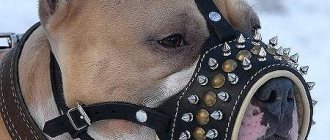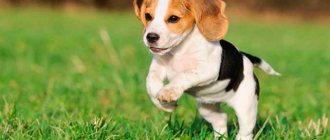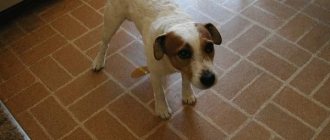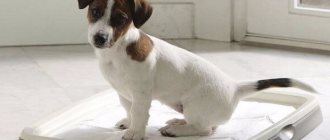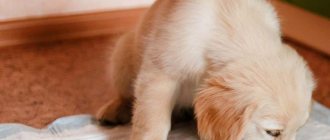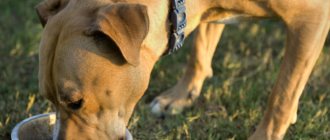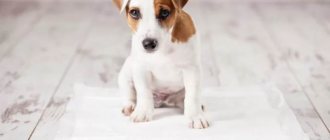The popularity of decorative dog breeds is largely due to the fact that they can be trained to use a tray. Not every owner has the opportunity to sit at home with a puppy for several months, running out into the street with him at the first natural call - for a busy person who is ready to walk the dog only once or twice a day, a diaper becomes a real salvation.
The dog’s habit of going to the toilet in a specially designated corner of the house helps to care for an elderly or injured pet, and also allows even a person with limited mobility to keep a four-legged pet. But its formation also requires basic knowledge and effort - you should read our article even if you plan to adopt a puppy from a breeder. Remember that in a new place the dog will need time to determine the place for the toilet. Natural difficulties also arise when retraining a pet that is already accustomed to relieving itself on the street.
At what age can a puppy be litter trained?
Puppies show the best results at the age of 4-5 months, but training can begin as early as 2-2.5 months. Don’t try to train a one-month old baby to a litter tray - due to its ineffectiveness, the idea will cost you your nerves. It is better to devote this time to establishing a trusting relationship with your pet and developing its social skills.
If you are adopting a puppy from a breeder - probably after 3 months of age - begin training the moment the dog arrives at home.
Popular sections:
Aquariums Sale of kittens and puppies Terrariums Products for cats Products for dogs
As for the timing of toilet training, they may vary depending on the conditions and individual characteristics of the pet. In conscious puppies learn to walk in a diaper on average in 2 weeks; some more time (about 2 months) is required to consolidate the skill.
The process can be speeded up by:
- later weaning from the mother or other adult dogs, when puppies begin to master the litter box, repeating after their older relatives;
- habituation of the animal by the breeder or previous owner;
- early weaning of the puppy if its parents did not go to the litter box or the pet was not trained in the previous home;
- absence of other animals and children in the house;
- long stay of the owner with the dog.
And remember, the older the pet, the more difficult it will be to retrain it.
When does a puppy begin to endure and ask to go to the toilet?
A properly trained puppy can ask to go to the toilet as early as 2 months.
As was already mentioned a little above, small puppies, due to their lack of intelligence, relieve themselves in places inappropriate for this in the first days. And if you consider that they do this very often, then this becomes quite a serious problem. In view of this, if you want your pet to be toilet trained from a very young age, then start training him as early as possible.
Although there is an opinion that only from the age of 6 months does a puppy begin to ask to go to the toilet, with proper training you can achieve such a reflex much earlier. This can be done quite easily, just by playing with it. The physiology of puppies is such that after intense movements they always go to the toilet. Therefore, if you play outdoor games with him and then leave him on a diaper for a couple of minutes, he will very quickly learn to go to the toilet in the right place.
And if you play with him at the same time, he will try to wait until you come and take him outside, and only after that he will defecate. If you follow these simple rules, you can train your pet to ask to go to the toilet even at 2 months of age.
Is it possible to litter train an adult dog?
Tray training an adult dog is difficult, but possible. This can be facilitated by the preservation of the senses, warm relationships with the owner and members of his family, as well as forced necessity (for example, the postoperative period). Be prepared to be patient - mastering the tray can take several months, and even a year to perfect the skill. If your pet has never used a diaper for its intended purpose before 12 months, it will take much longer for him to form a new habit.
Be sure to pay attention to your dog's toilet preferences. If she is used to walking, a roll of lawn grass, and subsequently a mat with artificial grass laid instead of filler, can “make friends” with the tray. If your pet rarely leaves the house, and chooses a place to suit his needs anywhere, you can train him to the litter box almost like a puppy.
Separately about diaper toilets
Today, on the shelves of pet stores and veterinary pharmacies you can see special diapers for pets. They are disposable and reusable, but they perform the same functions. Reusable diapers can be used more than 20 times, only washing is required after each dog bowel movement. It is important to understand that such diapers cannot be washed in automatic washing machines.
Often, diapers are used as litter for a litter box, but many dogs are afraid to go to such a toilet. It is possible to accustom a dog to diapers, but this should be done gradually so as not to cause stress in the animal. In addition, some dog breeders use diapers without a tray at all, placing them throughout the house. No one will argue here; everyone is the master of their own business.
When walking your dog, be sure to teach your pet to follow simple commands, and if you are new to training, we recommend that you familiarize yourself with the basic principles of dog training. You can also start training by selecting a toy or a puller simulator.
What breeds of dogs go to the litter box in the house?
Not all dog breeds are equally willing to be swaddled. Breed temperament and intellectual abilities must be taken into account. Among others, the following are considered “excellent” in the toilet issue:
- Yorkshire, toy and other small terriers;
- Pekingese and Japanese Chins;
- miniature dachshunds and poodles;
- Chinese Crested;
- Pomeranians;
- Pugs.
The more decorative the breed, the higher the pet’s chances of learning simple science.
Which is better: in a tray or outside?
Many dog breeders believe that it is better for a dog to go to the toilet outside rather than in an apartment. This option is very suitable for people who live in the private sector in their own home. Moreover, if you have a lot of free time and you only enjoy walking with your pet, it will also be useful for the dog. After all, daily walks develop in the animal the habit of going to the toilet only outside the house. But if you live in an apartment building, then constantly taking your four-legged friend outside to the toilet causes some difficulties.
In addition, veterinarians recommend that some breeds can be trained as soon as you bring your pet home:
- Yorkshire Terriers;
- Pugs;
- Pekingese;
- Spitz;
- Chinese Crested;
- Chihuahua.
The fact is that the size of these dogs differs little from the size of cats, and this makes it possible to select a tray for them without any problems. Only you have the choice of how to make going to the toilet comfortable for your pet. After all, if a dog feels good, goes to the toilet comfortably and correctly, it means that it is healthy and happy. And if the pet feels happy, then the owner will have no reason to be in a bad mood towards his pet.
How to choose a litter box for your dog?
When choosing a dog litter box, you should not rely only on your own measurements - it would be much better to “try on” the container and place your pet in it. For this reason, it is better to buy the first tray offline or on the recommendation of an experienced consultant. Do not forget that puppies grow very quickly, and therefore it is better to use a toilet for growth. There is a high chance that your four-legged friend will not like a tray that is too small - dogs prefer space.
Under no circumstances should you buy a cat litter box for your pet - cases of dogs being accustomed to them are known, but extremely rare.
The general principle of dog litter trays varies little depending on their type. A dog toilet is a tray made of plastic or galvanized metal, the bottom of which is covered with a diaper or a rubberized mat or grate. The smaller the breed or height at the withers, the lower the sides of the toilet should be. So, for Chihuahuas they often produce bellyless models.
For male dogs, models are produced with a special post, which allows you to avoid marks on walls and furniture. The post usually has a system of attachment to the grille, which allows you to rearrange it if necessary.
For owners with allergies, we can recommend trays with clamps, thanks to which the absorbent diaper is securely fastened, preventing the spread of odor throughout the house. Remember that the filler in devices of this type needs to be changed more often.
How to use a litter tray, diaper or newspaper
So, the puppy's first steps in the house. How to train a puppy to go strictly to one place? There are not many training methods; it all depends on the time and capabilities available to the owner.
There are several “coverings” for toilet training a dog:
- Tray – i.e. a tray, most often plastic, but it can also be metal (wood is not suitable because it absorbs moisture and odor), which may contain filler. The filler can be either cat absorbent, grass or torn paper, newspaper or diaper. But if for a cat a filler is most often mandatory, because... A cat has a strong instinct to hide excrement by burying it deeper so that there is no smell, while dogs do not have such a need for digging - so the dog does not need litter.
- Diaper . This can be a reusable diaper that can be washed (but not in an automatic machine), or disposable diapers that can be bought at any store or pharmacy.
- Newspaper is the most versatile option. Despite the fact that a disposable diaper is more pleasant for the dog’s paws and is softer, absorbs moisture well and prevents it from leaking onto the floor, the dog will prefer to go to the newspaper. To protect the floor from liquid, you can put an oilcloth or a reusable diaper under the newspaper.
Using all these methods couldn’t be easier - the main thing is to place all these surfaces in a place convenient for the dog.
A dog is a clean animal - it will not relieve itself anywhere, and even more so will not go to the toilet in a dirty place. Immediately, as soon as the pet goes to the toilet, the diaper or newspaper needs to be cleaned.
Teaching a puppy to go to the toilet correctly
When the owner has decided on which surface the puppy will go to the toilet, it is necessary to properly teach the dog to go to the toilet.
A puppy, like a small child, is physiologically unable to endure for long. At first you will have to take the dog to the toilet up to 10-12 times a day.
First of all, it is worth temporarily removing floor coverings, shoes and soft rags from the floor. If you are training your dog to go to the toilet on a hard surface, you should not allow him to pee even once on a soft-pile carpet. It is more pleasant for a dog to go to the toilet on a soft surface and then it will be very difficult to wean him off going on carpet or wearing shoes, especially since the soft surface absorbs odors very well.
It is very important not to scold the puppy if he suddenly gets dirty in the wrong place!
A violent reaction from the owner, screaming or spanking, even light ones, can greatly frighten the dog . The only thing that can be achieved in this way is to teach the puppy to hide to go to the toilet and instead of finding puddles or piles in a visible place, the dog will go to the toilet under the bed or behind the closet.
When a puppy wants to go to the toilet, his usual playful behavior changes to anxiety. The dog whines, marks time, walks in circles. It is important not to miss the change in the puppy’s behavior and quickly take him to a diaper, tray or newspaper. After the dog goes to the toilet, you need to praise the puppy and encourage this behavior with play. This should be done every time the puppy shows signs of anxiety and wants to go to the toilet.
In addition, the puppy must be swaddled immediately after sleeping and eating; all physiological processes in the puppy’s body occur at this time.
Dog Litter Litter
Unlike cats, who instinctively bury their excrement, dogs have no need for loose litter. For them, the absorbent characteristics of the material are a priority, since a clean dog would never go to a dirty, wet litter box.
Therefore, in trays without a grid, the most popular material for covering is newspaper or other paper, as well as a diaper. If your dog moves it with his paws or likes to play with the sheets, you might want to consider installing a grill or changing the litter.
The second place is occupied by special mats with artificial grass, or rubber options with special grooves. Rare dogs go to sawdust or other traditionally “cat” litter. Some owners even use hay as bedding.
It is often possible to do without a tray - if the dog is careful and does not move the toilet, you can lay a disposable or reusable diaper on the floor. The first option is more convenient in terms of time costs and is well suited for allergy sufferers, while the second is more economical and environmentally friendly. You can read more about diapers here.
Some general information
Today there are two options for making diapers for dogs:
- disposable;
- reusable.
Each of these types has its positive and negative sides.
Disposable products are suitable for one-time occasions. For example, you need to leave the animal alone for a relatively long time - a business trip for a day, a trip on an excursion, or even a banal trip to a friend’s birthday party. In this case, after returning home, the material is simply thrown away.
Reusable diapers are important for training puppies to use the proper toilet. Reusable products are denser and absorb liquid and odor better. But there is one very important nuance here - they must be washed regularly. If you are mentally prepared for this and have time, then reusable diapers are definitely preferable.
Be careful when choosing a manufacturer and suppliers. The fact is that high demand and not the lowest prices for the products themselves lead to an increase in the number of counterfeits. If you find a really worthy seller, then buy diapers from him constantly. Firstly, you will be protected from counterfeiting, and secondly, the dog will definitely know the location of the toilet.
And yet, if you think that you can completely replace walks on the street with the help of diapers, then you are very mistaken. Don’t look to make life easier for yourself - this is just a small element of care that reduces the consequences of “surprises” between walks or a long absence of the owners from home.
Choosing a location for the dog litter box
Initially, poor placement of the toilet can cause a lot of “misfires” in the puppy and lead to conflicts with the owner and family members. When choosing a location for your dog litter box, consider the following principles:
- the place should be convenient for both the puppy and the owner, since changing the location of the toilet has a negative impact on training;
- make sure that, in addition to the diaper, there are no other soft absorbent materials on the floor, such as carpets or rags;
- Try to choose a room where you can limit the puppy's movement.
For very small pets, you can build a fence, gradually increasing the living space from 1.5 sq.m as they grow. The fewer places to relieve yourself, the higher the likelihood that the dog will choose a diaper as a toilet.
Advice from experienced dog breeders
Breeders advise placing your pet in a fenced off corner after eating. Puppies go to relieve themselves after they wake up or eat. This happens at the level of the natural functioning of the body. Wait until the baby or adult dog pees and you can take your pet from there for active games. But if the puppy wants to sleep, leave him alone. Let him rest after eating.
The baby ran to the diaper, but didn’t have time and made a puddle nearby? A commendable endeavor. Blot the puddle with a diaper, and wipe the area with a rag, for example, with Domestos or whiteness. These products contain bleach, which kills the odor of urine. Rinse the rag and wipe again.
To quickly accustom it, periodically bring your pet to the place where the diaper lies. How many times a day? How much patience do you have? The puppy characteristically squats before peeing and spins around its own axis. If you keep an eye on it, you will definitely notice it and have time to transfer it to a diaper located in a tray or on a car mat.
How to train a dog to use a litter box?
1. Limit the space you can move. The most convenient way would be to organize the puppy’s living space so that it is always convenient for you to keep an eye on him. This will help you respond in a timely manner to your baby’s attempts to sit down.
2. For the time being, remove all soft bedding from the premises accessible to the puppy. Natural cleanliness often becomes the reason that a pet chooses the surface for the toilet that best absorbs urine and retains odors. What absorbs moisture better than carpets?
3. Choose a location for the litter box based on your puppy's preferences, or place it further away from the aisle.
4. Follow the regime. Usually puppies run to pee after waking up and poop after eating. Transfer your pet to the tray in advance, gently talking to him and stroking him. Don't forcefully hold your dog in the crate, but gently return him if he tries to run away without getting the job done. Do not let the puppy run around the entire apartment until he has had a bowel movement.
5. Be sure to reward your pet with vocal praise and a favorite treat immediately after completing the process.
6. Do not yell at the puppy, do not hit or humiliate him if he wanders by. If you catch your pet committing a crime, loudly and unexpectedly say “ugh,” clap your hands, and scold the puppy. A look of shame (ears flattened, pleading look) is more than enough. If you are late and an incident occurs, remove the feces and wash the floor thoroughly so that there is no smell left. Before doing this, it is advisable to dip a piece of paper in them and put it in the tray, leaving a kind of olfactory anchor for the puppy.
How to wean a puppy and an adult dog from going to the toilet at home and accustom it to the toilet outside?
The dog needs help choosing a place for toileting.
I would immediately like to say that a small puppy, especially if he has just moved to a new place of residence, will inevitably relieve himself wherever he wants. And he will do this not because he wants to spite you, but because he is not yet toilet trained. In view of this, if you do not want to walk through puddles, then try to teach the puppy to do this in the right place from the very first days.
If he has already chosen a place for the toilet, and it does not suit you, then the only correct solution would be to put a bowl of food and water there. Remember, even a small and stupid puppy will never relieve itself where it eats and sleeps. If he chose a place for the toilet where it is impossible to place food, then you can try to ward him off with the help of smells specific to him.
For example, you can wipe the area with rubbing alcohol or ammonia. Also, dogs do not like the smell of citrus fruits, so if you put the peel of an orange, lemon or grapefruit in this place, they will definitely start to avoid it. But in order for the dog not to continue to shit anywhere, at the same time as weaning it off, you must teach it to relieve its needs in the right place. Just keep in mind that this must be done correctly.
If you simply yell at your pet for what he has done, then after some time he will begin to do this in even more secluded places, thereby trying to avoid your anger. Therefore, it will be better if you put, for example, a newspaper in the place that he likes, and when he empties on it, just take it and move it to a more convenient corner for you. Since all dogs have a well-developed sense of smell, they will smell themselves in another place and after some time they will begin to go to the toilet where they need to go.
How to deal with learning difficulties?
If your dog does not use the litter box, take a closer look at his behavior and surroundings. Perhaps alternative bedding is preferable to diapers for her - in this case, it is worth excluding the pet’s access to carpets, beds, upholstered furniture and secluded places, such as boxes. Or the animal prefers dark corners, where it can relieve itself away from its owner’s eyes. This behavior is usually typical of adolescents and adult dogs that have undergone incorrect and traumatic training from previous owners.
When keeping a puppy, remember that little pets are just learning to control urination and defecation, and therefore trays and diapers should be within walking distance so that a child who is playing or overeating has time to reach them. Subsequently, the number of toilet places can be gradually reduced.
Dogs already accustomed to the street may look for a substitute for grass - for example, terry blankets. Lay them on a special mat or use natural materials as bedding for the first time.
If your pet is too clean or you are away from home for a long time, provide him with several litter trays so that he can go to the toilet without getting his paws dirty. Also, protest may be caused by the tray being too small, unstable, or having inconvenient sides.
For a dog of any age that has only recently arrived in the home, mastering the living space is inextricably linked with setting boundaries. Being territorial animals, dogs instinctively mark their territory, often marking places where boundaries may be violated by strangers - near doorways and window openings. Do not forget to limit the area of movement for the first time, and also do not take into bed an animal that does not yet control its urges.
If your pet came to you as an adult, pay attention to whether it gets along with your household, whether it gets enough attention, and whether it competes with other pets. In some cases, violation of toilet rules may indicate diseases of the genitourinary tract, conflict with someone at home, or boredom. Sometimes castration of a pet that is not intended for breeding helps solve the problem. Trays with posts are offered for breeding dogs to demonstrate their dominance.
Remember that dogs prefer to go to the toilet in the same place, which retains their scent. Be sure to clean the wrong areas using household and special products to avoid relapses. Sometimes products such as “Antipis” and “Antiodor” for surface treatment help solve the problem.
If none of the methods helped you, as well as the recommendations of the breeders, think about purchasing dog diapers. They will also help you avoid unpleasant incidents at a party.
Useful tips
There are a number of useful tips and recommendations for training a dog to use a tray, which were compiled by experienced dog breeders and veterinarians:
- Immediately after eating or sleeping, lock your pet in a room with a litter box. The fact is that the dog, at the subconscious level, will want to defecate after eating and after resting.
- When locking an animal in a room with a poop container, expect a happy ending and never open the door prematurely. If the job is done according to the rules, then praise the dog; if everything is not as you expected, scold, but without being too enthusiastic.
- The door to the room with the toilet container must always be open. If your pet does not have time to reach the toilet, you need to wipe the puddle with a diaper and put it in the tray. The place where the dog defecated must be thoroughly washed to remove excess odors. Otherwise, the dog will smell this place the next time he wants to go to the toilet.
- Regularly take your dog to the diaper tray and point out in a firm tone that this is his toilet.
- Never raise your voice too loudly or for too long at a dog, especially don’t hit him. He is able to remember all the grievances; In addition, excessive stress can lead to regular urination in the wrong place.
Important! When cleaning the house, it is prohibited to use bleach and ammonia. The fact is that urine also contains ammonia, which can attract the animal to defecate in the wrong place.
What not to do?
Be consistent and clear in the process of training your puppy, try to maintain his sense of trust in a person and safety in your society. Also remember that to create a conditioned reflex, it is necessary to maintain the shortest possible time intervals between the action and the reward. Absolutely not worth it:
- praise or blame your pet upon discovering a pile or puddle, if they were not made in your presence;
- spanking or otherwise physically punishing the dog, especially before 4 months of age when puppies are especially susceptible;
- use only negative motivation and do not reward your pet after correct actions;
- forget about negative reinforcement (even if you are soft-hearted, to raise a dog you still need to establish what is acceptable and what is not);
- punish the pet by depriving it of food or entertainment;
- lock it up with the stool or poke your nose into it;
- use ammonia detergents (they may have the opposite effect).
It is very important to reinforce in the dog’s mind the sequence “if you missed the tray, you met with condemnation.” If you punish the puppy not for the prank itself, but for the excrement that is subsequently discovered, he will most likely begin to hide traces of the crime - for example, lick it off in fear of punishment or shit in secluded corners.
Spray for toilet training a puppy: how to use?
Recommendations for using the spray
If you want to teach your pet to go to the toilet as quickly as possible, then you can try doing this with a special spray. Its action is based on a specific odor, which encourages animals to defecate in the area where it is sprayed. As practice shows, when using this product, the dog stops shitting in the house after about 10 days.
Recommendations for using the spray:
- Choose a suitable location for the toilet
- Put a diaper there or put up artificial turf
- Apply spray in this area
- In order for the dog to smell the smell, literally 2-3 clicks on the can are enough.
- Bring your dog in and let him sniff the treated area.
- Do this until she goes to the toilet in this place
- After emptying, be sure to treat your pet with something tasty.
- Spray the selected area with the spray until the puppy develops a strong reflex.
What is a toilet diaper and what is it used for?
Dog diapers are common among owners. They are comparable in principle and effectiveness to baby diapers and feminine pads. Due to the waterproof bottom layer and adsorbent, water does not leak out and odor does not spread. Diapers are placed in a tray or used as a full-fledged toilet for a pet. They are also used when teaching a puppy to pee in one place.
The main advantages are:
- Ability to absorb liquid quickly. The diaper remains dry on the surface, which provides the animal with comfort.
- Resistant to damage, it is difficult to tear it with claws.
- The volume of absorbed moisture is 2 liters.
- The adsorbent contains no dangerous or harmful substances.
Its varieties
Diapers sold in pet stores are divided into three types:
- Disposable. They will need to be thrown away after use. This is an economical option. Available in different colors and sizes. Sometimes they have a sticky bottom layer that helps stick the diaper to a smooth surface.
- Reusable. Their validity period is up to 12 months. It is necessary to wash the diaper at least once every two to three days. Use any cleaning products for processing. It contains an absorbent substance that firmly holds liquid, so that the surface will always be dry. The cost of the type in question is much higher, but this is due to its cost-effectiveness in use.
- Accustoming. They have all the qualities discussed above. The diapers also have a scent that pets mistake for the smell of grass. This makes it easier to accustom the puppy to a diaper in the apartment and a toilet outside in the future. This type is also suitable for elderly and sick animals.
Certain types have built-in humidity indicators. They indicate to the owner that the diaper requires washing or replacement. There are options with antibacterial impregnation.
